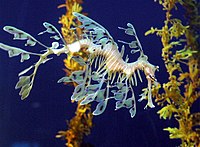
Photo from wikipedia
The late (post-Triassic) carnivorous dinosaurs show a wide morphological diversity, which most probably reached the highest level during the Cretaceous Period, the longest in the Phanerozoic (80 Ma) and represented… Click to show full abstract
The late (post-Triassic) carnivorous dinosaurs show a wide morphological diversity, which most probably reached the highest level during the Cretaceous Period, the longest in the Phanerozoic (80 Ma) and represented the time of the last and longest f lourishing of the entire group. The Late Cretaceous, which lasted slightly less than half of this period, probably displays the majority of the entire diversity known in the morphological evolution of theropods. This was to a considerable extent facilitated by the especially favorable conditions for preservation of fossils that developed during this time, being the major cause of abundance of the fossil record. When considering the diversity of late carnivorous dinosaurs, at least two approaches are possible. First, to compare all theropod groups, which are represented by diverse and abundant material, but, nevertheless, overcome inevitable incompleteness and sometimes low informativeness, along with discrepancy of mass material. This way is more suitable for large reports, for example, The Dinosauria (2004) and other similar reviews. The second way is shorter and more expressive, that is, to allocate a limited number of theropods, no more than two or three groups, based at least on the following conditions: the data on the chosen groups should be sufficiently complete (although this does not mean that our knowledge is complete) to present in a generalized form the similarity and dissimilarity of compared characters; in so doing, it is desirable that considerable contrast and opposition of some characters and simultaneously rather high identity of others would only emphasize the amplitude of their structural modifications and innovations; another important point is conditionally more or less equivalent susceptibility to general directedness in morphological evolution of late carnivorous dinosaurs toward the avianlike pattern. In our case, these conditions are met by Dromaeosauridae (Matthew and Brawn, 1922) and Oviraptoridae (Barsbold, 1976a). These theropods existing for almost half a century “in reserve” owing to disarming incompleteness of our knowledge of them have unexpectedly been brought to the forefront (the first just at the beginning and the second in the 1970s), when new additional data resulted in the second more sound discovery of the group, which followed the first dated 1922 and 1924, respectively (Matthew and Brawn, 1922; Osborn, 1924). New data have shown remarkable innovations in the structure of each lineage (Ostrom, 1969; Barsbold, 1976b, 1981), the set of which had previously not known in carnivorous dinosaurs as a whole. Subsequently, the taxonomic composition of each group, which initially included a few species, essentially expanded. Dromaeosaurids and oviraptorids are characterized by expressiveness and stability of their structure within the historical time of their existence and clear directedness of development toward the avianlike pattern, ornithization.1 However, the last was apparently shared by all Theropoda
Journal Title: Paleontological Journal
Year Published: 2018
Link to full text (if available)
Share on Social Media: Sign Up to like & get
recommendations!